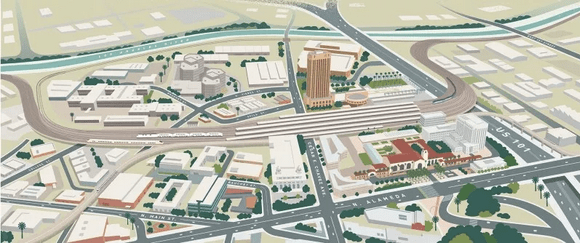Metro is proposing eliminating some unneeded potential components of its "LinkUS" Union Station run-through tracks project. Pending board approval, the changes would reduce the overall project cost, improving chances that it will get built.
The Union Station run-through tracks project is sort of the overlooked stepchild of L.A. rail. Metro is the lead agency for the project, which will primarily benefit Metrolink, Amtrak, and future high-speed rail riders - with no significant impact on Metro rail operations. Though Metro has been studying some form of Union Station run-through tracks for about two decades, the overall design still has not been finalized. The project was not funded in county sale tax Measures M or R. It is not on the Olympics acceleration project list, nor in the consolation prize unfunded ancillary efforts list. LinkUS has Metro board support, but does not really have a strong board champion.
All this is unfortunate as LinkUS is a crucial component for streamlining rail transportation throughout the region. The project will correct the stub-end track design that has made Union Station inefficient for its 80 year history. That inefficiency is at the heart of the region's rail networks; fixing it essentially takes away friction that slows down overall operations. Metro estimates that run-through tracks will increase Union Station capacity (from 180 to 278 trains daily) and reduce train dwell times (from 20 minutes to five minutes).
Metro is currently in the final stages of its LinkUS environmental studies.
Last night Metro hosted an open house meeting to share the latest changes to the project. These changes are expected to go to the Metro board for approval later this month - first at the June 19 Planning and Programming Committee.
As recently as 2017, Metro had been considering an above-grade concourse design for LinkUS. This would have likely resulted in a fancy edifice that would have been impractical for riders making connections. When Metro received numerous public comments against the above-grade design, it responded by eliminating it.
The new design concept would widen the existing concourse hallway running below the tracks. That hallway is currently 29.5 feet wide; new designs would widen it to 100 or 140 feet. This means that Metro would more-or-less upgrade its existing facility, rather than an extensive, expensive re-do.
Another change proposed is the elimination of a planned "loop track." Seen in the top right of the above image, the loop track would have allowed trains exiting the station's southern end to easily head north. Eliminating the loop track has a small adverse impact on the flexibility of future operations. What it does, though, is shrink the footprint of the run-through tracks elevated structure, resulting in greatly reduced project cost. By having a smaller structure, the project avoids impacts to a half-dozen properties immediately south of the 101 Freeway that Metro would have needed to purchase or negotiate easements on.
All in all, without big concourse re-works and the loop track, the overall LinkUS project budget would go from an estimated $2.7-$3.3 billion down to an estimated $2.3 billion. This cost savings may be just enough for the project to get funded and built in the near term.
Metro only has about $950 million in funding for LinkUS; the funds are primarily from CA high-speed rail and cap and trade, via the Transit and Intercity Capital Rail Program - TIRCP. That money is anticipated to essentially build just new elevated structure over the 101 Freeway - with tracks connecting to the south.
An unfunded second phase - costing nearly $2 billion - would make extensive changes to Union Station itself, including widening the concourse hallway, raising the platforms, adding throat tracks, etc.
For additional details on LinkUS, see coverage at The Source and Urbanize - and the Metro project webpage, which includes the draft environmental studies.






